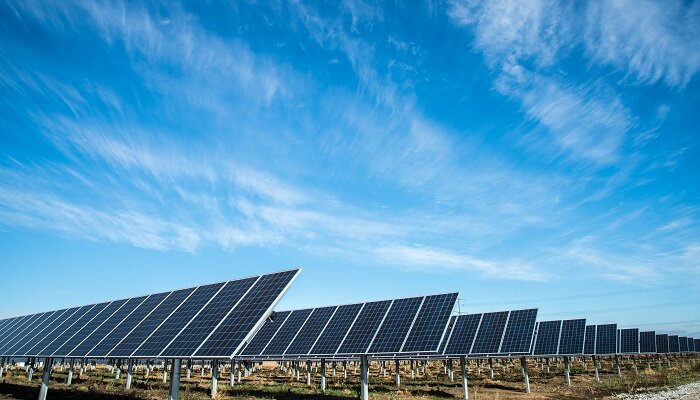The construction industry is undoubtedly one of the most vital sectors on the planet, building essential structures such as schools, hospitals, and housing that our society relies on, and are always in high demand.
Unfortunately, construction is also one of the most damaging industries to our environment, contributing to 50% of climate change and generating large quantities of waste, air pollution, and harm to local wildlife.
In a time when the climate crisis is worsening, and sustainability is at the forefront of everyone’s minds, the construction industry is facing more pressure to find new and innovative ways of lowering their negative impact on the environment.
What Is Solar Energy?
The sun provides us with one of the most abundant renewable energy resources we can utilise in constructing both industrial and domestic structures. Solar energy plays an essential role in reducing CO2 gas emissions and mitigating the damage caused to the planet when mining for fossil fuels.
Fossil fuels are a non-renewable resource formed by fossilised plants and animals, meaning that once they’re gone, they’re gone for good- or at least for a very long time. As the population rises and demand for these resources increases, we are burning our supply faster than we can find them.
We use fossil fuels in the form of natural gas, coal, and oil to heat our homes, fuel our cars, and manufacture all kinds of goods that we consider essential to maintaining our quality of life. However, burning fossil fuels is highly unsustainable and incredibly harmful to the environment.
When fossil fuels burn, they emit dangerous greenhouse gas emissions contributing to global warming. In the face of the current climate crisis, we can expect extreme heat waves, rising sea levels, melting ice caps, droughts, and other catastrophic environmental impacts unless immediate transformative action is taken.
As one of the leading contributors to global warming, many are turning to the construction industry to start making changes.
What Is Sustainable Construction?
Sustainable construction is a building method that many companies are beginning to adopt in an effort to lower their carbon footprint and reduce their negative impact on the environment.
While sustainable construction methods do come with their own set of challenges, it is essential for construction companies to create buildings that contribute to positive changes in society while keeping their energy consumption to a minimum in the process.
Modern technology also makes the transition easier, helping construction businesses make their projects more sustainable. Solar panels are just one example of such technology, helping companies use energy more efficiently to lower carbon emissions and reduce energy bills while on-site.
Solar panels gather energy from the sun and convert it into electricity or heat to provide power for all kinds of machinery. Energy-saving solar panels are also a common feature on new-build houses as the world shifts to a more sustainable future. In fact, an average of almost 12,000 solar panels are installed in UK homes per month, demonstrating their growing popularity.
Find out more at https://www.greenmatch.co.uk/solar-energy/solar-panels.
How To Make Construction More Sustainable
If you own a construction business, you may wonder what kind of sustainable building methods your company can adopt to lower your negative impact and promote a more eco-friendly work ethic to employees and customers. These are just some of the ways to make construction more sustainable.
Using Renewable Energy
As mentioned previously, solar energy has many incredible benefits that construction companies can utilise in several ways. By including solar energy in housing projects, companies can assist more people in the community in using clean, renewable energy throughout their everyday lives. Adding solar panels to new houses can decrease energy waste and increase home value by making solar technology more widely accessible.
Solar energy is not just for powering houses, as solar panels can be used to power a range of electrical devices, machinery, and construction tools. Advancements in technology have seen the development of battery-powered vehicles which you can charge using renewable solar energy. These innovations have massively positive implications, reducing the need for fossil fuels on construction sites and helping companies save money on non-renewable resources.
Reduce Construction Waste
The construction industry produces an estimated ⅓ of the world’s landfill waste. Landfill can cause all sorts of problems for our environment, producing harmful gasses that pollute the air and soil.
Reducing and responsibly disposing of waste on construction sites can help sustain the environment and reduce costs. Construction waste refers to any materials or substances not used during construction that are abandoned and discarded. Such materials may include ceramics, bricks, tiles, paint, glass, plastic, pipes, and insulation.
There are various ways to be more mindful of waste on construction sites. Ordering the precise number of materials is one example. Buying more materials than you need will inevitably lead to waste. By ensuring that you order the exact number of materials needed for the job, you can actively reduce the amount that goes to landfill waste.
Another method to reduce landfill waste through construction is using sustainable materials that you can easily recycle. Materials like wood, metal, brick, and concrete can easily be repurposed in other areas, helping to keep costs down while eliminating waste.
Use Equipment Efficiently
Keeping equipment up-to-date and well maintained is key to them running efficiently and consuming less energy. For example, old or faulty equipment may need to work harder to produce the required output, making it slow and inefficient. Using renewable energy where possible can also contribute to higher efficiency levels in equipment and machinery.




































